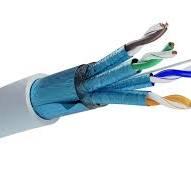Let’s not waste time—if your network has to handle heavy data loads, power over Ethernet, or operate in a noisy environment, you need shielded Cat6a cables. They're not just upgraded wires. They’re infrastructure built to carry modern networks on their back—faster, cleaner, and more reliably.
This post will break down why shielded Cat6a is the go-to for demanding environments, what sets it apart from unshielded alternatives, and where it fits into your network architecture.
What Is a Shielded Cat6a Cable?
Let’s start with the basics.
Cat6a stands for Category 6 Augmented. It supports:
-
10 Gigabit Ethernet over 100 meters,
-
with a bandwidth of 500 MHz,
-
and lower crosstalk than Cat6.
Now, when you add shielding to that mix, you’re adding a layer of protection around each twisted pair (or the entire cable) that blocks out electromagnetic interference (EMI) and radio frequency interference (RFI).
Shielding types vary:
-
F/UTP (Foiled/Unshielded Twisted Pair): foil around all pairs
-
U/FTP (Unshielded/Foiled Twisted Pair): foil around each individual pair
-
S/FTP (Shielded/Foiled Twisted Pair): braid shield + foil per pair
Each option offers a different level of protection depending on how noisy your environment is.
Why Speed Alone Isn't Enough
Sure, Cat6a is fast—10 Gbps over the full 100 meters. But in real-world networks, raw speed isn't the only metric that matters.
The problem? Most modern environments are noisy as hell—electrically speaking.
Here’s what can kill performance if you don’t use shielded cables:
-
Crosstalk from nearby network cables
-
EMI from fluorescent lights, motors, HVAC systems, power lines
-
Alien crosstalk (NEXT from adjacent cables in the same bundle)
That’s where shielding saves the day. It’s like giving your data a soundproof, EMI-proof highway to travel on.
Performance That Holds Up Under Pressure
If you're running:
-
10 Gigabit backbones in data centers,
-
VoIP phones in office buildings,
-
Industrial Ethernet in factories,
...then shielded Cat6a isn’t a luxury—it’s the standard. Here's why:
1. Consistent High-Speed Transmission
The shielding maintains signal integrity even over longer distances. Unlike unshielded cables that degrade in noisy conditions, shielded Cat6a performs predictably—even in the worst environments.
2. Lower Packet Loss
Interference can lead to dropped packets, retransmissions, and jitter. Shielded Cat6a dramatically reduces this risk. That means fewer hiccups in video calls, smoother streaming, and reliable transfers.
3. Ideal for PoE++ (up to 100W)
Power over Ethernet is everywhere now—think IP cameras, access points, smart lighting. Shielded Cat6a handles higher wattage without overheating, thanks to reduced insertion loss and better heat dissipation.
Unshielded vs. Shielded: The Real Tradeoff
Let’s be honest—shielded Cat6a is more expensive. You’ve got higher material costs, tougher installation requirements, and stricter grounding needs.
But here’s the thing:
| Unshielded Cat6a | Shielded Cat6a |
|---|---|
| Lower cost | Higher cost |
| Easier to install | Requires grounding |
| Prone to interference | Blocks EMI/RFI |
| Less consistent at 10G | Stable 10G over 100m |
| Okay for small offices | Ideal for industrial, data centers |
If you're installing in a quiet, well-separated office network, unshielded might be fine. But if there’s interference anywhere—or you just want bulletproof performance—shielded is the smarter call.
Installation Tips: Do It Right or Don't Bother
Shielded cables only work if you treat them properly. If you're not careful, you could make things worse than if you’d used unshielded to begin with.
1. Ground Everything
The shielding must be connected to a proper ground at both ends. Skip this, and you’ll turn the shield into a giant antenna that attracts more noise.
2. Use Shielded Connectors
Don't mix and match. Pair shielded cables with shielded keystone jacks, patch panels, and RJ45 plugs—or you break the shielding chain.
3. Avoid Sharp Bends
Too much bending or pinching can deform the foil and reduce effectiveness. Maintain proper bend radius.
4. Test Before You Close It Up
Run a cable certification test. Don’t wait until the drywall’s up to find out your cable isn’t properly grounded.
Common Use Cases for Shielded Cat6a
You’ll find shielded Cat6a in places where performance and stability can’t be compromised:
-
Hospitals: Sensitive medical equipment + network gear = major EMI risk.
-
Factories: Industrial machinery wreaks havoc on unshielded cables.
-
Broadcast Studios: Audio/video systems are super sensitive to interference.
-
Data Centers: High-density cabling + 10G speeds = a perfect storm for alien crosstalk.
-
Smart Buildings: PoE-powered lighting, sensors, and security systems benefit from reduced heat and interference.
The Future-Proofing Factor
You might think, “Why not wait for Cat7 or Cat8?”
Good question.
Here’s the deal:
-
Cat7 isn’t officially recognized by TIA/EIA and uses proprietary connectors.
-
Cat8 is overkill for most buildings (supports only 30m at 25/40G).
Cat6a hits the sweet spot: fast, future-ready, widely supported, and available with shielding that turns it into a tank.
If you're running cables behind walls or through conduit, you want something that’ll last at least 10-15 years. Shielded Cat6a checks that box.
Final Word: Know Your Environment, Then Decide
Don't buy shielded Cat6a just because it sounds fancy. Buy it because:
-
You need reliability in high-interference zones.
-
You’re running long 10G lines.
-
You’re delivering high-power PoE.
-
Or you simply don’t want to deal with signal issues five years from now.
If any of those apply to you, shielded Cat6a isn’t just the right cable—it’s the only cable that makes sense.
And once it's installed and grounded correctly, you’ll stop worrying about your cable—and start focusing on what actually matters: performance that doesn’t flinch.

